Occupational Environment Monitoring at Air Conditioner Manufacturing Factory
99,000 ₫
Note: The above price is calculated per sample and may vary depending on the area of the environment to be monitored and market fluctuations. For more accurate pricing support, please refer to the price list or contact our consulting staff directly.
Monitoring the environment of an air conditioner production factory is a session for collecting, analyzing, and evaluating workplace factors that may be harmful to workers’ health.
Table of Contents
Toggle1. Overview of Air Conditioner Manufacturing Factories
a. What is an Air Conditioner Manufacturing Factory?
A manufacturing factory for air conditioners is a production facility specializing in the manufacturing and assembly of air conditioning equipment. Air conditioners are electronic devices used to cool and regulate the air in buildings, vehicles, and other spaces.
In an air conditioner manufacturing factory, production, assembly, and inspection processes are carried out to produce high-quality air conditioning products.

b. Production Stages in an Air Conditioner Manufacturing Factory
In an air conditioner factory, production, assembly, and inspection processes are implemented to ensure high-quality products. Key production stages include:
- Design and Research: The factory conducts design and research processes to develop new air conditioner models and upgrade technology and features. Engineers and research teams work to create efficient and advanced designs.
- Procurement and Material Management: The factory contacts suppliers and purchases components, parts, and materials required for production, including compressors, fans, controllers, copper pipes, casings, and other components.
- Production and Assembly: The production and assembly process involves organizing production lines, assembling components, and completing the assembly of air conditioners. This includes metalworking, electronic assembly, casing assembly, and attaching other components.
- Inspection and Quality Control: After assembly, inspection and quality control processes are performed to ensure products meet standards and quality requirements. Air conditioners are tested for functionality, performance, noise levels, and compliance with safety regulations.
- Packing and Shipping: After quality control, air conditioners are packed and prepared for transport to sales outlets or consumer units. Packaging is done to protect products and ensure safety during transportation.

c. Machinery Used in Air Conditioner Manufacturing Factories
Air conditioner factories use various machinery and equipment for production and assembly. Common machinery includes:
- Copper Pipe Cutting and Bending Machines: Used to cut and bend copper pipes, an important component in air conditioning systems.
- Metalworking Machines: Used for cutting, milling, and turning metal parts of air conditioners, including casings and other components.
- Plastic Extrusion Machines: Used to create plastic parts such as casings, controllers, and other components.
- Compressors: The main component of an air conditioner; compressors are used to generate the pressure and flow of refrigerant needed for cooling.
- Welding Machines: Used to weld metal parts together, forming strong and durable joints.
- Automated Assembly and Testing Machines: Automated machines assemble components into finished air conditioners. Testing machines then check functionality, performance, and safety.
- Pressure and Vacuum Testing Machines: Used to test the pressure and vacuum of the cooling system during production.

d. Occupational Diseases for Workers in Air Conditioner Factories
Workers in air conditioner manufacturing factories may be at risk of several occupational diseases related to the work environment and production processes. Common occupational diseases include:
- Respiratory diseases: Exposure to strong fumes, dust, and smoke during production may cause pneumonia, asthma, sinusitis, and bronchitis.
- Skin diseases: Contact with chemicals such as solvents, cleaners, and adhesives can cause irritation, inflammation, and other skin conditions.
- Eye problems: Strong light, UV exposure, and mechanical impacts may cause eye strain, redness, conjunctivitis, and other vision issues.
- Heat-related illnesses: High temperature and humidity in the workplace may cause heat shock, heatstroke, and other heat-related conditions.
- Hearing issues: Noise from machinery and production processes may lead to hearing loss, tinnitus, and other ear-related problems.
- Musculoskeletal disorders: Repetitive movements and heavy labor may cause spinal, muscle, and joint problems such as vertebral degeneration and back pain.

e. Popular Types of Air Conditioners on the Market
Common types of air conditioners used in homes, offices, stores, and other spaces include:
- Window Air Conditioner: Installed on a window or wall. Compact, easy to install, suitable for small spaces.
- Split Air Conditioner: Consists of an indoor unit and an outdoor unit. Cooling and control are provided through copper pipes and electrical connections between the two units.
- Central Air Conditioner: A complex system used for large spaces such as office buildings, shopping centers, and hotels. It includes a chiller unit to cool water and a duct system to distribute cooled air.
- Portable Air Conditioner: Mobile air conditioner that can be easily moved. Common in rented apartments, bedrooms, or small offices.
- Heat Pump: Can both cool and heat. Used to cool in summer and provide heating in winter.
- Wall-mounted Air Conditioner: Installed on walls with a sleek design, suitable for small to medium spaces.
- Cassette Air Conditioner: Installed in the ceiling with air vents to distribute cooled air, ideal for wide and high-ceiling spaces.

2. Overview of Occupational Environment Monitoring Services
a. What is Occupational Environment Monitoring for Air Conditioner Factories?
Occupational environment monitoring (or workplace environment measurement) in air conditioner factories involves collecting, evaluating, and analyzing workplace environmental indicators to take timely measures, minimize environmental impacts on worker health, and prevent occupational diseases. It is a mandatory requirement for air conditioner manufacturing factories.
Occupational environment monitoring is critical for protecting and promoting worker health, as workers are the main resource and directly generate profits for the company. Frequent exposure to hazards exceeding permissible limits can adversely affect health and cause occupational diseases.
REGISTER FOR OCCUPATIONAL ENVIRONMENT MONITORING SERVICE
b. Nam Viet’s Occupational Environment Monitoring Program
Nam Viet’s monitoring program is developed by engineers specializing in occupational safety and environmental protection. To ensure worker health and safety, it uses modern methods to monitor air, water, microclimate, physical, and dust factors. This program is essential for maintaining a safe working environment and protecting worker health.
Additionally, Nam Viet’s program helps research and develop solutions to improve workplace environmental quality. With the professionalism and dedication of its expert team, Nam Viet’s exclusive monitoring program is a breakthrough in occupational safety and environmental management in Vietnam.

c. Standardization in Occupational Measurement Procedures
Standardization ensures accurate and reliable measurement results. The program follows recognized standards of the Ho Chi Minh City Department of Health. Data collected is highly reliable for evaluating workplace environments and making decisions to protect worker health.
Standardized procedures are conducted by highly qualified monitoring specialists with years of experience, ensuring managers and experts can trust Nam Viet’s results for accurate, valuable occupational health decisions.
d. Reporting Results of Occupational Environment Monitoring for Air Conditioner Factories
Monitoring results are prepared according to Form No. 04, Appendix III issued with Decree 44/2016/ND-CP and made in two copies: one for the contracting factory and one retained by the monitoring organization.
Monitoring results are retained indefinitely in accordance with the law.

e. Frequency of Occupational Environment Monitoring as Required by Law
According to Clause 2, Article 18 of the Labor Safety and Hygiene Law 84/2015/QH13, employers must conduct occupational environment monitoring at least once per year.
f. Deadline for Submitting Occupational Environment Monitoring Reports
Reports must be submitted before December 31 each year. Enterprises must submit monitoring results to the Department of Health in the locality where the business is headquartered and where employees work.
If production technology or processes change, or when facilities are upgraded, enterprises must update occupational hygiene records regarding new hazards that require environmental monitoring.
g. Penalties for Violations of Occupational Environment Monitoring by Employers
According to Article 27 of Decree 12/2022/ND-CP dated January 17, 2022:
- Clause 2: Fine of 2,000,000 – 5,000,000 VND for not publicly disclosing monitoring results to workers immediately after obtaining them.
- Clause 3: Fine of 20,000,000 – 40,000,000 VND for failing to conduct monitoring to control hazards affecting worker health as required by law.
- Clause 4: Fine of 40,000,000 – 60,000,000 VND for colluding with monitoring organizations to commit fraud, without criminal liability.
3. Harmful Environmental Factors for Workers in Air Conditioner Manufacturing Factories
Workers in air conditioner manufacturing factories may encounter several harmful environmental factors. Some of the main factors include:
- Chemicals: During air conditioner production, chemicals such as solvents, refrigerants, cleaning agents, and adhesives may be used. Long-term exposure to these substances can have harmful health effects, including dermatitis, respiratory inflammation, and damage to internal organs.
- Noise: Air conditioners and related equipment often produce noise during operation. Continuous and high noise levels can cause hearing problems, stress, insomnia, and negative impacts on workers’ overall health.
- Bright lighting: Production and inspection processes in factories may produce intense lighting, including sunlight and light from equipment. Prolonged exposure to bright light can lead to eye problems such as eye strain, conjunctivitis, and more severe eye damage.
- Temperature and humidity: During air conditioner production, factories may have high temperature and humidity environments. Excessive heat and humidity can cause heat shock, fatigue, difficulty breathing, dehydration, and body temperature imbalance.
- Dust and particles: Metal processing and the use of materials such as plastic and rubber can generate airborne dust and particles. Exposure to dust and particles can lead to respiratory issues, pneumonia, and other breathing problems.
REGISTER FOR OCCUPATIONAL ENVIRONMENT MONITORING SERVICE
4. Measures to Improve the Work Environment in Air Conditioner Manufacturing Factories
Improving the work environment in air conditioner manufacturing factories is crucial for protecting health and ensuring worker safety. Some measures to improve the factory work environment include:
- Health, Safety, and Environment (HSE) management system: Implement an HSE system to ensure compliance with labor safety regulations and standards. This includes identifying and assessing environmental risks and establishing procedures and regulations to minimize risks for employees.
- Training and education: Provide training and education related to workplace safety and environment. Ensure all employees are instructed on safety procedures, proper use of Personal Protective Equipment (PPE), waste handling, and other safety regulations.
- Chemical control: Use measures to control chemical exposure, such as PPE (gloves, safety glasses), effective ventilation systems, and other practices to minimize contact with hazardous chemicals.
- Noise management: Assess and reduce factory noise through soundproofing, insulation, ear protection, and using quieter equipment. Ensure employees wear ear protection to safeguard hearing.
- Temperature and humidity adjustment: Ensure comfortable temperature and humidity conditions in the work environment. Use effective air conditioning systems, provide adequate water for hydration, and employ cooling methods such as fans and misting machines.
- Dust and particle management: Assess and control dust and particles in the work environment using dust extraction systems, regular cleaning procedures, providing respiratory protective equipment, and instructing employees on proper handling.
- Create a comfortable work environment: Provide a comfortable workspace with sufficient natural light, cleanliness, and ventilation. Ensure employees have breaks and opportunities to restore health.
- Monitoring and evaluation: Regularly monitor and evaluate environmental factors in the factory, including air quality, temperature, humidity, noise, and other conditions to ensure compliance with safety and environmental standards.
- Regularly conduct occupational environment monitoring in factories to collect and analyze harmful factors affecting workers, then adjust to reduce risks and prevent occupational diseases.
5. Benefits of Regular Monitoring in Air Conditioner Manufacturing Factories
An Toàn Nam Việt provides businesses with valuable benefits when using occupational environment monitoring services in accordance with Decree 44/2016/NĐ-CP on managing and controlling harmful factors in the work environment affecting employees.
- Businesses can proactively monitor harmful factors in their factories.
- Receive advice and recommendations on measures to reduce harmful factors and improve the work environment quality.
- Indirectly protect human resources, a key factor in business development.
- Minimize the impact of occupational diseases on workers’ health, thereby reducing future medical treatment costs.
- Enhanced worker health improves product quality and ensures consistent production output.
- Ensure compliance with labor safety regulations, avoiding legal risks.
- Enhance credibility and professionalism in all aspects, boosting the company’s brand image.
Nam Viet’s environmental monitoring service is a solution to mitigate occupational disease impacts and contribute to creating a clean and high-quality work environment.

6. Nationwide Occupational Environment Monitoring Center
Nam Viet Occupational Environment Monitoring Center is a professional unit specializing in monitoring and measuring workplace environmental quality throughout all provinces of Vietnam. With an experienced team of environmental monitoring specialists, the center uses modern measuring equipment to ensure accuracy and reliability.
In addition to providing monitoring services, the center supports clients in planning, handling, and following up on occupational environment issues. With the motto “customer-centered,” the center prioritizes client satisfaction, meets all client needs, and commits to providing the best solutions.
REGISTER FOR OCCUPATIONAL ENVIRONMENT MONITORING SERVICE
With investment in technology, equipment, and human resources, Nam Viet’s monitoring center has become a reputable unit in occupational environment monitoring in Ho Chi Minh City, with the following goals:
- Value brand reputation and service quality.
- Provide clients with the best and most suitable solutions.
- Work with experienced Masters and Engineers aiming to protect the environment and benefit businesses.
- Offer professional services by experts in environmental monitoring and provide cost-effective advantages.
The occupational environment monitoring process at Nam Viet includes the following basic steps:
- Before monitoring, ensure all equipment is calibrated and adjusted according to legal requirements.
- Carry out the monitoring process as committed to the Department of Health.
- Report accurate monitoring results to employers.
- If monitoring results indicate unsafe conditions for workers, Nam Viet will provide corrective solutions, and the factory will implement:
- Implement measures to improve working conditions, minimizing harmful factors and preventing occupational diseases.
- Organize medical check-ups to detect occupational and work-related illnesses for employees in unsafe environments.
- Provide compensation in kind for workers according to labor law regulations.

7. Occupational Environment Monitoring Price List
To help businesses conduct professional and effective occupational environment monitoring, Nam Viet provides clients with a detailed and reasonably priced service price list.
- Our price list provides detailed information on the costs of all monitoring services, including transportation, measurement, analysis, and reporting. Clients can be confident in the accuracy and reliability of the monitoring reports provided.
- We are committed to offering competitive and reasonable prices while providing prompt and professional consultation on any service-related inquiries.
- With Nam Viet’s price list, clients can easily select services that best meet their needs. We guarantee maximum satisfaction with professional service quality.
No comments yet

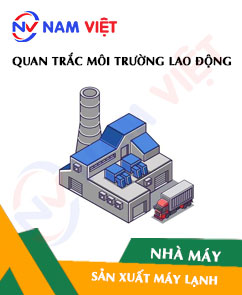
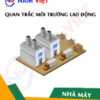
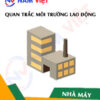


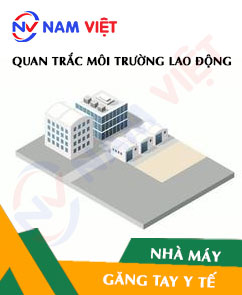


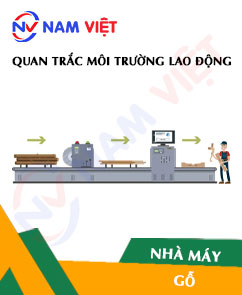
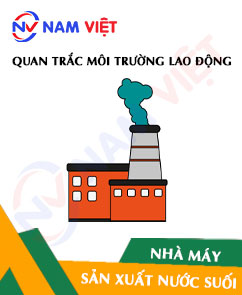

Review Occupational Environment Monitoring at Air Conditioner Manufacturing Factory
There are no reviews yet.